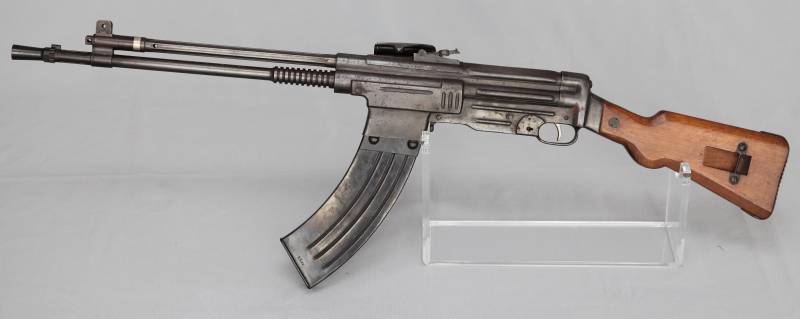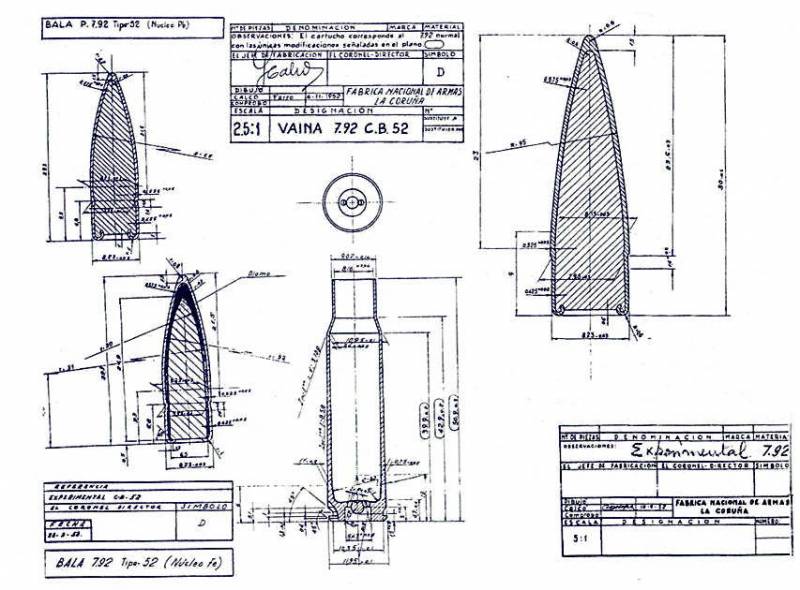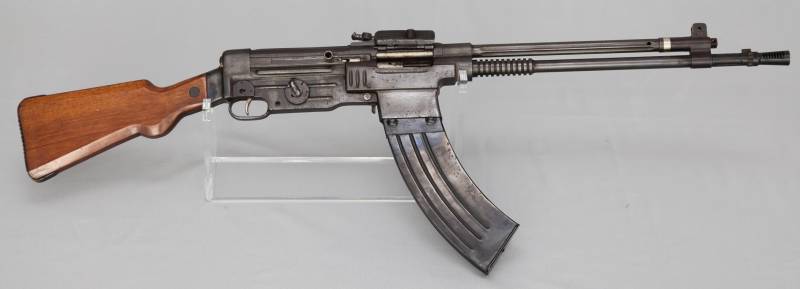Automatic rifle CB-52 (Spain)
The appearance of the CB-51 rifle was preceded by a long enough program of studying the German intermediate cartridge 7,92x33 mm Kurz. The Spanish military has shown interest in this ammunition, and also initiated the development of their own weapons using it. Different versions of weapons were offered, and one of them was an automatic rifle by designer H. De La Calzada-Bayo called CB-51. It to some extent resembled the existing German designs, although it had noticeable differences.
The first version of the Fusil Asalto CB-51 rifle was designed for the Kurtz 7,92x33 cartridge. In addition, a new modification of this weapon soon appeared, which was to use the 7,92x40 mm ammunition of its own Spanish design. Both rifles were based on common ideas, but different ammunition led to some discrepancies in the design, primarily related to the size of the cartridge.
In the 1951-52, two variants of the CB-51 rifle were tested, during which they showed ambiguous characteristics. Some of the parameters could meet the requirements, while others were insufficient. In particular, it left much to be desired range effective fire. Even with the “long” cartridge 7,92х40 mm, which was distinguished by a larger weight of gunpowder, the rifle could not hit targets at a distance of 1 km, as the customer wanted. Thus, both the CB-51 automatic rifles were of no interest to the Spanish army and had no chance of getting into service.
Taking into account the identified shortcomings of weapons of its own design and the wishes of the military, Lieutenant Colonel H. De La Calzada-Bayo returned to the design work. According to the results of the study of the available opportunities, the designer came to the conclusion that it was necessary to use a completely new cartridge that can show compliance with the requirements. The main aspects of weapons for such an ammunition, however, could be left unchanged. In this case, the rifle should have been finalized in a certain way to obtain some advantages over its predecessors.
The available 7,92x33 mm and 7,92x40 mm cartridges differed by an insufficiently large cartridge case in which the desired powder charge could not be placed. In addition, the size of such ammunition imposed restrictions on the length and mass of the bullet. For his next rifle, H. De La Calzada-Bayo decided to develop an entirely new cartridge, characterized by the required characteristics. At the same time, however, such a product was based on some developments on existing cartridges.
The cartridge, designated CB-52 or “Type 52”, received a flangeless bottle sleeve with a length of 51 mm. If certain grounds assume that the cartridge case for the Spanish cartridge was a reworked element of German ammunition 7,92x57 mm. In particular, the outer diameters of the two sleeves coincided with an accuracy of a few hundredths of a millimeter. It was proposed to place a pointed bullet with a diameter of 8,17 mm and a length of 30 mm in a sleeve box. For hinge and combat characteristics, the resulting cartridge 7,92x51 mm CB-52 should have occupied an intermediate position between the German 7,92x57 mm and the Spanish 7,92x40 mm.
The 7,92x51 mm CB-52 cartridge differed from the existing 7,92x57 mm product in smaller sizes and reduced characteristics, which, theoretically, made it possible to attribute it to an intermediate class. Nevertheless, the authors of the project have designated their new cartridge as rifle.
Experience testing two rifles arr. 1951 of the year showed that the existing design of weapons, in general, meets the requirements and therefore does not need to be radically altered. As a result, when creating a new CB-52 rifle, it was necessary to modify the existing units for a new larger cartridge, as well as change some details. The rest of the two models "Fuzil asalto" could be identical.
The layout of the previous samples was saved in the new project. All major parts should be placed in a detachable receiver. The barrel and tube of the gas piston were fixed on the front of it, there was a magazine receiver on the bottom, and the rear part was intended for installing a wooden butt. The test results of the CB-51 rifles made it possible to discard some of the parts, but the new cartridge demanded that other devices be introduced.
The new weapons project, which was a development of the previous one, received the designation Fusil Asalto CB-52 - “Assault rifle Calsada Bayo arr. 1952. ”Since this project created only one weapon, there is no risk of any confusion.
The barrel box of the CB-52 rifle, as before, consisted of two large parts. The upper unit was a box-like device for mounting the barrel, gas engine and gate. Also in its front lower part there was a large receiver of a store with a short shaft. With the help of transverse pins with the upper part of the receiver fastened lower. She served as the casing of the firing mechanism. In addition, its high rear part was the cover of the receiver and had attachments for mounting the stock.
The new automatic rifle received a relatively long rifled barrel caliber 7,92 mm with chamber for 51-mm sleeves. The barrel was again equipped with fins at the breech. Near the muzzle was the body of the gas chamber with the necessary internal channels. Innovation project CB-52 was a large conical muzzle brake with a set of transverse slots in the upper part. It is curious that the new rifle was not equipped with a tubular barrel cover. At the same time, she also lost her forearm, which protected the shooter’s hands from the heated barrel and casing.
Directly above the barrel was placed a gas piston tube, facilitated by the valleys on the outer surface. According to reports, a long-lasting piston was used, which connected to the top of the bolt carrier. Thus, the rifle used the principle of long stroke.
Inside the top of the receiver was a bolt carrier with all the required devices. In front of her fixed bolt and gas piston, behind which there were devices to communicate with a separate cocking handle. In the new project, the handle was connected to the cover plate moving in the slot of the receiver and protecting the receiver from dirt. Previous rifle arr. 1951 did not have such protection.
There are no exact details on the design of the gate. Available photographs suggest that the shutter was not equipped with radial lugs for locking by turning. Thus, the barrel and bolt could be connected by skewing the latter or by other means corresponding to the characteristics of the weapon and cartridge. Inside the gate there was a channel for a spring-loaded drummer controlled by a trigger trigger.
Directly behind the gate was a return spring. It should be noted that the characteristic appearance of the rifles of Joaquín de la Calzada-Baya is the reason for the assumptions about the borrowing of ideas from the German projects of “assault rifles”. In this case, however, some design problems were solved in a different way. In particular, the return spring was completely able to be placed in the receiver, without putting it into the butt.
USM automatic rifle arr. 1952 was based on aggregates of previous products, but had some differences. It was proposed to control the fire with the help of a trigger shifted to the rear wall of the receiver. The locking mechanisms or the choice of fire mode were still carried out using a rolling flag. At the same time, it was transferred from the left wall of the box to the right one and noticeably moved forward. Under the displaced flag a new circular plate with tags was installed. The checkbox, depending on its position, ensured the blocking of mechanisms, single-fire or bursts of fire.
The ammunition system was based on detachable stores with 30 ammo capacity. They were offered to be placed in the receiving shaft under the receiver. In its place, the store was fixed with the front stop and the rear latch. The empty sleeve was thrown right upwards with the mash. The window for ejection of sleeves was covered with a spring-loaded lid. During the shooting, she would lean back up, whereas in the transport position she had to close and protect the weapon from contamination.
Rifle Fusil Asalto CB-52 received updated sights. The body of the gas chamber now served as the basis for the installation of a mobile front sight, placed inside the U-shaped protection. On the central part of the top of the receiver was set open mechanical sight with the ability to adjust the range and amendment to the wind.
The updated weapon, in general, retained the ergonomics of the previous models. On the rear wall of the receiver there was a protruding part for mounting the wooden rifle butt. Hold the weapon was proposed for the neck of the butt, equipped with a pistol protrusion. It was the shape of the butt that caused the location of the trigger and its protective guard. Unlike the base CB-51, the new CB-52 rifle did not have a shank. Apparently, gunsmiths proposed to hold the weapon for the store and the front of the receiver.
In the course of developing the original project, gunsmiths decided to abandon the bayonet. The CB-51 rifles could be equipped with a blade mounted on the muzzle of the barrel and the influx under the body of the gas chamber. The new product CB-52 has received a new large muzzle brake, which excluded the installation of the bayonet. In this regard, the lower part of the gas engine casing was made smooth, without any projections.
It is known that in 1952, the arsenal of La Coruna produced a number of experienced CB-52 automatic rifles. In addition, the State Cartridge Plant in Palencia received an order for the production of a batch of original 7,92x51 cartridges mm “Type 52”. All these products were submitted to the factory and state tests. Unfortunately, there is no detailed information on inspections by the manufacturer’s arsenal and the army. Nevertheless, the outcome of the project is known - the rifle did not receive recommendations for adoption.
There is reason to believe that the improved rifle, created on the basis of not the most successful predecessors, still had a chance to show themselves at the best range. In particular, the reinforced cartridge allowed to obtain the desired firing characteristics, such as the effective range of fire. The presence of several modes of fire increased the combat potential, allowing to solve all the existing tasks.

The souvenir cartridge 7,92x51 mm CB-52, released in 2010 in the part of the 1-th Congress of Spanish weapons collectors. For the participants of the event, 40 of such products was released.
At the same time, the CB-52 rifle could have some technical, technological or operational deficiencies that could affect the outcome of the project. Nevertheless, it can be assumed that the weapon did not fall into the army not because of its shortcomings, but because of the principled decisions of the command. In the early fifties of the last century, Spanish commanders worked on plans for the modernization of the armed forces, and the rifle of H. de la Calzada-Bayo might not correspond to the decisions taken.
In the first half of the fifties, gunsmiths of the United States developed a new rifle cartridge 7,62x51 mm T65. In 1954, it was adopted by the American army and recommended for use as a standard ammunition of the armed forces of NATO countries. The promotion of this cartridge within the Alliance has led to some specific consequences in the context of a number of small arms projects.
Under pressure from the leadership of NATO and the American side, the Spanish command decided to adopt a new rifle cartridge of foreign development. At the same time, the CB-7,92 mm 51x52 own product was to be abandoned. The consequences of such a decision were obvious. Spanish designers should either abandon part of existing projects or rework them using the new T65 cartridge.
Apparently, the rifle Fusil Asalto CB-52 was the "victim" of such circumstances and decisions of the command. In its original form, it did not correspond to the plans of the military leaders and therefore was not of interest to the army. The situation could be rectified with the help of an updated project involving the use of the NATO 7,62x91 mm cartridge.
Some sources mention the design of the updated CB-52 for the American cartridge. However, there is no information about the completion of such work. Apparently, a similar project - if it was developed - did not even reach the testing stage. In addition, during this period, the Spanish industry worked on new small arms projects that had certain advantages over CB-52. A rifle from the arsenal of A Coruña would have to face serious competition that impedes the flow of troops.
For one reason or another, the command did not begin to adopt the CB-52 rifle and order its mass production. After a few years, the rearmament of the army began using other weapons. The military preferred to buy modern designs developed by the designers of the CETME center.
Several test rifles CB-52 were made for use in testing. After completing the checks and rejection by the main customer, most of these products were apparently disposed of. At the moment, only one surviving rifle of this type is known. Now this product is stored in the military history museum of the Museo Histórico Militar de A Coruña (La Coruña). In addition to the only surviving CB-52, there are two prototypes of CB-51 in the storage rooms of this organization, one for each cartridge.
Lt. Col. Joaquin De La Calzada Bayo made a great contribution to the development of modern small arms in Spain. He participated in the development of various submachine guns, rifles, cartridges, etc. However, not all of his creations were successful in terms of commerce and exploitation. However, without such successes, Calzada Bayo rifles represent a great technical and historical interest.
On the materials of the sites:
http://forgottenweapons.com/
http://claus.espeholt.dk/
http://modernfirearms.net/
http://municion.org/
http://karelmilitary.livejournal.com/
- Ryabov Kirill
- Forgottenweapons.com, Municion.org



Information